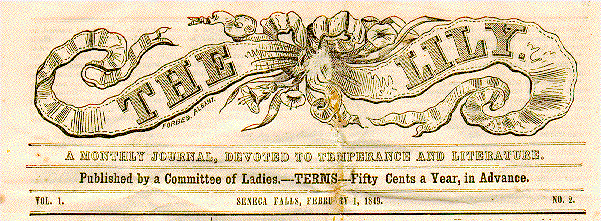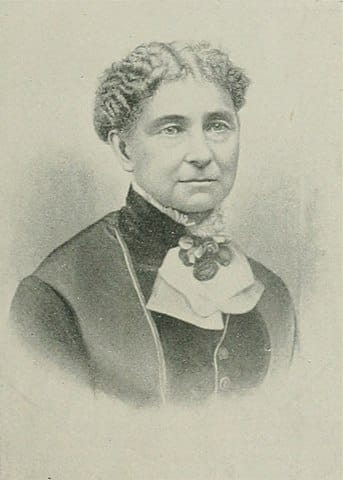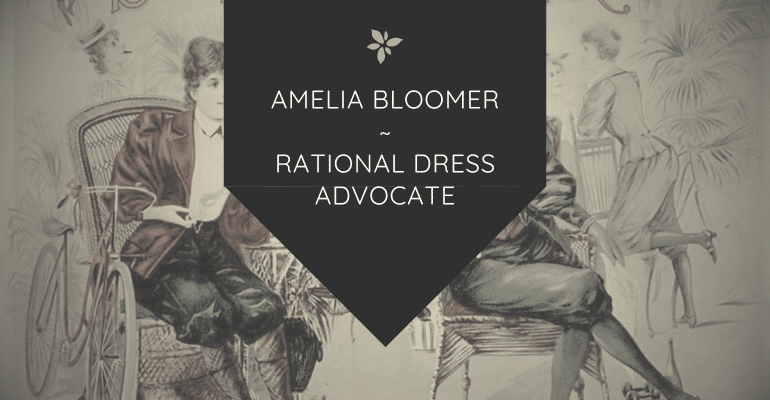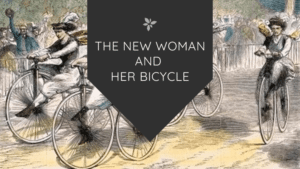Amelia Bloomer was a women’s rights activist famous for popularizing “bloomers.” A women’s rights activist, writer, and editor, she founded a newspaper called The Lily which she used to advocate for women’s suffrage and temperance as well as more sensible dress for women.
The Early Life of Amelia Jenks Bloomer

Amelia Bloomer was born Amelia Jenks in 1818 to a middle-class family in New York. After graduating school she worked as a teacher for a short time before gaining employment as a live-in tutor and governess for a wealthy family. It was at this job that she met Dexter Bloomer, a local attorney she fell in love with and soon married at the age of 22.
Dexter Bloomer, besides working as an attorney, was co-owner and editor of the Seneca Falls County Courier, a local newspaper. He encouraged Amelia to begin writing for the paper about the temperance movement, which she was deeply passionate about.
This was the start of her writing career that eventually launched her to fame and linked her name to the costume she advocated.
The Lily Newspaper

Amelia Bloomer first became interested in women’s rights after attending the famous Seneca Falls Convention, the first women’s rights convention, which was held near her home in 1848.
Less than a year later, she started her own newspaper to write about her views on the subject. She wanted to be active in the movement, but, like most people at the time, felt that it wasn’t a woman’s place to speak in public. She believed that writing was the best way for women to campaign for suffrage and other rights.
Amelia Bloomer’s newspaper, The Lily, was published biweekly from 1849 to 1853. She not only wrote for the paper, but edited contributions from other women including famous suffragist Elizabeth Cady Stanton, who she had met at the Seneca Falls Convention. The newspaper, which began with a focus on temperance, gradual became more radical and moved on to cover a wide variety of topics including women’s rights, suffrage, and dress reform.
History of Bloomers

At the time, women wore confining corsets which could cause health issues. The long skirts and petticoats they were expected to wear also restricted their movement, making it difficult to even walk around easily. A woman’s full outfit, including corset, heavy skirts, bustles, and padding could weigh over 15 pounds.
In The Lily, Amelia Bloomer advocated for dress reform for women. She was introduced to a new type of costume invented by Elizabeth Cady Stanton’s cousin, Elizabeth “Libby” Smith Miller: loose, full pants gathered at the ankle and topped with a short dress, or with a skirt and vest. Amelia Bloomer and Stanton found the new outfit charming, comfortable, and most of all sensible, and adopted it immediately.

However, the women were completely unprepared for the intense reaction the costume would provoke. It was ridiculed in the press, and wearers were harassed every time they went outside. Amelia said she “stood amazed at the furor I had unwittingly caused”. Stanton soon abandoned the costume under pressure from not only foes, but friends and family. Amelia, however, was determined to stick with it and used The Lily to campaign for all women to adopt the costume, even publishing sewing patterns for it. Though not the inventor, Amelia Bloomer’s efforts led to the costume becoming famous as The Bloomer Costume, or “bloomers” for short.
By the 1850s, the crinoline, a rigid steel structure meant to be worn under a skirt to shape it in the required fashion, was becoming popular. Amelia eventually gave in to the pressure and harassment and abandoned the bloomer costume for crinolines, since they were much lighter and easier to move around in than the heavy layers of skirts worn previously.
Amelia Bloomer Quotes
The costume of women should be suited to her wants and necessities. It should conduce at once to her health, comfort, and usefulness; and, while it should not fail also to conduce to her personal adornment, it should make that end of secondary importance.
It will not do to say that it is out of woman’s sphere to assist in making laws, for if that were so, then it should be also out of her sphere to submit to them.
[The Lily] was a needed instrument to spread abroad the truth of a new gospel to woman, and I could not withhold my hand to stay the work I had begun. I saw not the end from the beginning and dreamed where to my propositions to society would lead me.
It is woman that speaks through The Lily… Intemperance is the great foe to her peace and happiness. It is that above all that has made her Home desolate and beggared her offspring… Surely, she has the right to wield her pen for its Suppression. Surely, she may without throwing aside the modest refinements which so much become her sex, use her influence to lead her fellow mortals from the destroyer’s path.
Though Amelia Bloomer is famous today for the article of clothing that bears her name, she accomplished a lot more than that. Her newspaper, The Lily, may have been the first woman-owned and operated newspaper in the United States, paving the way for later women’s suffrage periodicals to emulate her publishing success and educate the public on women’s rights. A temperance advocate and active suffragist, she served as president of the Iowa Woman Suffrage Association from 1871 until 1873.
Amelia Bloomer unfortunately died in 1894, and did not live to see the 19th Amendment passed in 1920 granting women suffrage.
Keri is a blogger and digital marketing professional who founded Amazing Women In History in 2011.






Leave a Reply